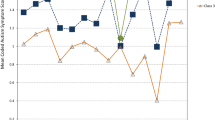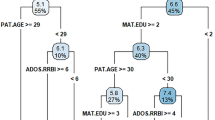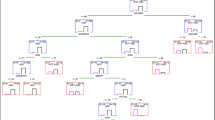Abstract
A recent cross-sectional analysis of PDD Behavior Inventory (PDDBI) data, analyzed with a classification and regression tree algorithm, yielded a decision tree (the Autism Spectrum Disorder-Decision Tree or ASD-DT) that detected three behaviorally distinct ASD subgroups: minimally verbal, verbal, and atypical. These subgroups differed in PDDBI profiles and in factors previously reported to be predictors of autism severity and adaptive behavior trajectories. We retrospectively analyzed trajectories of adaptive skills and autism severity in these subgroups, defined by ASD-DTs calculated from initial evaluation PDDBIs. Results confirmed predictions that each subgroup had distinct trajectories that varied with the type of adaptive behavior assessed suggesting that the ASD-DT has prognostic value that could be helpful for both clinical and research applications.







Similar content being viewed by others
References
Anderson, D. K., Liang, J. W., & Lord, C. (2014). Predicting young adult outcome among more and less cognitively able individuals with autism spectrum disorders. Journal of Child Psychology and Psychiatry, 55(5), 485–494.
Anderson, D. K., Oti, R. S., Lord, C., & Welch, K. (2009). Patterns of growth in adaptive social abilities among children with autism spectrum disorders. Journal of Abnormal Child Psychology, 37, 1019–1034.
Baghdadli, A., Assouline, B., Sonie, S., Pernon, E., Darrou, C., Michelon, C., et al. (2012). Developmental trajectories of adaptive behaviors from early childhood to adolescence in a cohort of 152 children with autism spectrum disorders. Journal of Autism and Developmental Disorders, 42, 1314–1325.
Breiman, L., Friedman, J. H., Olshen, R. A., & Stone, C. J. (1984). Classification and regression trees. Monterey, CA: Wadsworth and Brooks/Cole Advanced Books and Software.
Christensen, D. L., Baio, J., Van Naarden, B. K., Bilder, D., Charles, J., Constantino, J. N., et al. (2016). Prevalence and characteristics of autism spectrum disorder among children aged 8 Years—Autism and Developmental Disabilities Monitoring Network, 11 Sites, United States, 2012. Morbidity and Mortality Weekly Report Surveillance Summaries, 65, 1–23.
Cohen, I. L. (2017). PDDBI professional manual supplement: Autism spectrum disorder decision tree. Lutz, FL: Psychological Assessment Resources, Inc.
Cohen, I. L., Liu, X., Hudson, M., Gillis, J., Cavalari, R. N., Romanczyk, R. G., et al. (2016). Using the PDD Behavior Inventory as a Level 2 screener: A classification and regression trees analysis. Journal of Autism and Developmental Disorders, 46, 3006–3022.
Cohen, I. L., Liu, X., Schutz, C., White, B. N., Jenkins, E. C., Brown, W. T., et al. (2003a). Association of autism severity with a monoamine oxidase A functional polymorphism. Clinical Genetics, 64, 190–197.
Cohen, I. L., Schmidt-Lackner, S., Romanczyk, R., & Sudhalter, V. (2003b). The PDD Behavior Inventory: A rating scale for assessing response to intervention in children with pervasive developmental disorder. Journal of Autism and Developmental Disorders, 33, 31–45.
Cohen, I. L., & Sudhalter, V. (2005). The PDD Behavior Inventory. Lutz: Psychological Assessment Resources, Inc.
Cohen, I. L., Vietze, P., Sudhalter, V., Jenkins, E. C., & Brown, W. T. (1989). Parent-child dyadic gaze patterns in fragile X males and in non-fragile X males with autistic disorder. Journal of Child Psychology and Psychiatry, 30(6), 845–856.
Farmer, C., Swineford, L., Swedo, S. E., & Thurm, A. (2018). Classifying and characterizing the development of adaptive behavior in a naturalistic longitudinal study of young children with autism. Journal of Neurodevelopmental Disorders, 10, 1.
Fountain, C., Winter, A. S., & Bearman, P. S. (2012). Six developmental trajectories characterize children with autism. Pediatrics, 129(9), 1–9.
Freeman, B. J., Del’Homme, M., Guthrie, D., & Zhang, F. (1999). Vineland Adaptive Behavior Scale scores as a function of age and initial IQ in 210 autistic children. Journal of Autism and Developmental Disorders, 29, 379–384.
Gotham, K., Pickles, A., & Lord, C. (2012). Trajectories of autism severity in children using standardized ADOS scores. Pediatrics, 130, e1278–e1284.
Griffiths, R. (1984). The abilities of young children: A comprehensive system of mental measurement for the first eight years of life (revised edition). Bucks: A.R.I.C.D. The Test Agency Limited.
Liang, K.-Y., & Zeger, S. L. (1986). Longitudinal data analysis using generalized linear models. Biometrika, 73, 13–22.
Lord, C., Bishop, S., & Anderson, D. (2015). Developmental trajectories as autism phenotypes. American Journal of Medical Genetics Part C: Seminars in Medical Genetcs, 169(2), 198–208.
Nisbet, R., Elder, J., & Miner, G. (2009). Handbook of statistical analysis and data mining applications (1st ed.). Burlington, MA: Academic/Elsevier.
Sparrow, S., Cicchetti, D. V., & Balla, D. A. (2005). Vineland adaptive behavior scale-II. Circle Pines, MN: American Guidance.
Sparrow, S. S., Balla, D. A., & Cicchetti, D. V. (1984). Vineland adaptive behavior scales. Interview edition. Survey form manual. Circle Pines, MN: American Guidance.
Sparrow, S. S., Cicchetti, D. V., & Saulnier, C. A. (2016). Vineland adaptive behavior scales (3rd edition, Vineland-3). San Antonio, TX: Pearson.
StataCorp. (2017). Stata: Release 15. Statistical software. College Station, TX: StataCorp LLC.
Stevens, M. C., Fein, D. A., Dunn, M., Allen, D., Waterhouse, L. H., Feinstein, C., & Rapin, I. (2000). Subgroups of children with autism by cluster analysis: A longitudinal examination. Journal of the American Academy of Child and Adolescent Psychiatry, 39(3), 346–352.
Szatmari, P., Georgiades, S., Duku, E., Bennett, T. A., Bryson, S., Fombonne, E., et al. (2015). Developmental trajectories of symptom severity and adaptive functioning in an inception cohort of preschool children with autism spectrum disorder. JAMA Psychiatry, 72, 276–283.
Zeger, S. L., & Liang, K.-Y. (1986). Longitudinal data analysis for discrete and continuous outcomes. Biometrics, 42, 121–130.
Acknowledgments
The authors would like to thank the many families that participated in these studies and J. Helen Yoo, Ph.D., for her assistance with information on the Vineland-II and Vineland-3 for this manuscript. This research was supported by funds from the New York State Office for People with Developmental Disabilities, the NYS Special Legislative Grant for Autism Research, and by Grant #12-FY99-211 from the March of Dimes Birth Defects Foundation to Ira L. Cohen.
Author information
Authors and Affiliations
Contributions
ILC developed the idea for analyzing trajectories as a function of the subgroups, evaluated all cases, performed the data analyses, and wrote the manuscript. MJF suggested the use of GEE models to analyze the longitidinal data and independently confirmed all of the analyses. He also reviewed the manuscript.
Corresponding author
Ethics declarations
Conflict of interest
The PDDBI generates a royalty, 50% of which is used to support research at the Institute with the other 50% distributed to the authors of the PDDBI. Dr. Cohen is one of the authors. Dr. Flory declares that he has no conflict of interest.
Ethical Approval
All procedures performed in the research studies described above were in accordance with the Ethical Standards of the Institutional and/or National Research Committee and with the 1964 Helsinki Declaration and its later amendments or comparable ethical standards.
Informed Consent
Informed consent was obtained from all caregivers participating in the various research projects included in this study.
Additional information
Publisher’s Note
Springer Nature remains neutral with regard to jurisdictional claims in published maps and institutional affiliations.
Rights and permissions
About this article
Cite this article
Cohen, I.L., Flory, M.J. Autism Spectrum Disorder Decision Tree Subgroups Predict Adaptive Behavior and Autism Severity Trajectories in Children with ASD. J Autism Dev Disord 49, 1423–1437 (2019). https://doi.org/10.1007/s10803-018-3830-4
Published:
Issue Date:
DOI: https://doi.org/10.1007/s10803-018-3830-4




